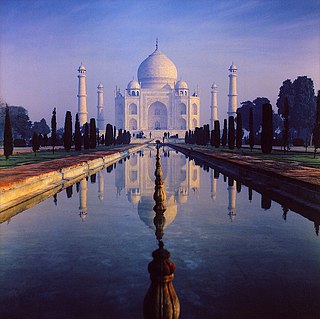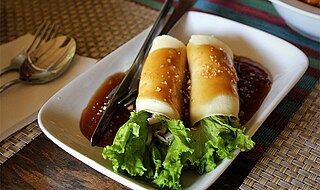
A dragon is a large, serpentine legendary creature that appears in the folklore of many cultures around the world. Beliefs about dragons vary drastically by region, but dragons in western cultures since the High Middle Ages have often been depicted as winged, horned, four-legged, and capable of breathing fire. Dragons in eastern cultures are usually depicted as wingless, four-legged, serpentine creatures with above-average intelligence.

Ramadan or Ramazan is the ninth month of the Islamic calendar, observed by Muslims worldwide as a month of fasting (sawm), prayer, reflection and community. A commemoration of Muhammad's first revelation, the annual observance of Ramadan is regarded as one of the Five Pillars of Islam and lasts twenty-nine to thirty days, from one sighting of the crescent moon to the next.

Chinese dragon, also known as East Asian dragon or Long or Lung, are legendary creatures in Chinese mythology, Chinese folklore, and East Asian culture at large. Chinese dragons have many animal-like forms such as turtles and fish, but are most commonly depicted as snake-like with four legs. They traditionally symbolize potent and auspicious powers, particularly control over water, rainfall, typhoons, and floods. The dragon is also a symbol of power, strength, and good luck for people who are worthy of it in East Asian culture. During the days of Imperial China, the Emperor of China usually used the dragon as a symbol of his imperial strength and power.

Eid al-Fitr, , also called the "Festival of Breaking the Fast", is a religious holiday celebrated by Muslims worldwide that marks the end of the month-long dawn-to-sunset fasting of Ramadan. This religious Eid is the only day in the month of Shawwal during which Muslims are not permitted to fast. The date for the start of any lunar Hijri month varies based on when the new moon is sighted by local religious authorities, so the day of celebration varies by locality.
A dragon boat is a human-powered watercraft originating from the Pearl River Delta region of China's southern Guangdong Province. These were made of teak, but in other parts of China, different kinds of wood are used. It is one of a family of traditional paddled long boats found throughout Asia, Africa, the Pacific islands, and Puerto Rico. The sport of dragon boat racing has its roots in an ancient folk ritual of contending villagers, which dates back 2000 years throughout southern China, and even further to the original games of Olympia in ancient Greece. Both dragon boat racing and the ancient Olympiad included aspects of religious observances and community celebrations, along with competition.

Central Java ; Javanese: ꦗꦮꦠꦼꦔꦃ) is a province of Indonesia, located in the middle of the island of Java. Its administrative capital is Semarang. It is bordered by West Java in the west, the Indian Ocean and the Special Region of Yogyakarta in the south, East Java in the east, and the Java Sea in the north. It has a total area of 32,548 km², with a population of 34,552,500 million in mid 2019, making it the third-most populous province in both Java and Indonesia after West Java and East Java. The province also includes the island of Nusakambangan in the south, and the Karimun Jawa Islands in the Java Sea. Central Java is also a cultural concept that includes the Special Region and city of Yogyakarta. However, administratively the city and its surrounding regencies have formed a separate special region since the country's independence, and is administrated separately. Although known as the "heart" of Javanese culture, there are several other non-Javanese ethnic groups, such as the Sundanese on the border with West Java. Chinese Indonesians, Arab Indonesians, and Indian Indonesians are also scattered throughout the province.

Semarang is the capital and largest city of Central Java province in Indonesia. A major port during the Dutch colonial era, and still an important regional centre and port today. The city has been named as the cleanest tourist destination in Southeast Asia by the ASEAN Clean Tourist City Standard (ACTCS) for the year of 2020 to 2022.

Pasar malam is an Indonesian and Malay word that literally means "night market". A pasar malam is a street market in Indonesia, Malaysia, Brunei and Singapore that opens in the evening, usually in residential neighbourhoods.

Book of Imaginary Beings was written by Jorge Luis Borges with Margarita Guerrero and published in 1957 under the original Spanish title Manual de zoología fantástica. It was expanded in 1967 and 1969 in Spain to the final El libro de los seres imaginarios. The English edition, created in collaboration with translator Norman Thomas di Giovanni, contains descriptions of 120 mythical beasts from folklore and literature.
The Water Festival is the New Year's celebrations that take place in Southeast Asian nations such as Cambodia, Laos, Myanmar, and Thailand as well as among the Dai people of China. It is called the 'Water Festival' by Westerners because they notice people splashing or pouring water at one another as part of the cleansing ritual to welcome the New Year. Traditionally people gently sprinkled water on one another as a sign of respect, but as the new year falls during the hottest month in South East Asia, many people end up dousing strangers and passersby in vehicles in boisterous celebration. The act of pouring water is also a show of blessings and good wishes. It is believed that on this Water Festival, everything old must be thrown away, or it will bring the owner bad luck.
Grobogan is a regency located in northeastern part of the Central Java province in Indonesia.

Javanese cuisine is the cuisine of Javanese people, a major ethnic group in Indonesia, more precisely the province of Central Java, Yogyakarta and East Java. Though the cuisine of Sumatra is known for its spiciness with notable Indian and Arabic influences, Javanese cuisine is more indigenously developed and noted for its simplicity. Some of Javanese dishes demonstrate foreign influences, most notably Chinese.

Tumpeng is an Indonesian cone-shaped rice dish with side dishes of vegetables and meat originating from Javanese cuisine of Indonesia. Traditionally featured in the slamatan ceremony, the rice is made by using a cone-shaped woven bamboo container. The rice itself may be plain steamed rice, uduk rice, or yellow rice.

The mythology of Indonesia is very diverse, the Indonesian people consisting of hundreds of ethnic groups, each with their own myths and legends that explain the origin of their people, the tales of their ancestors and the demons or deities in their belief systems. The tendency to syncretize by overlying older traditions with newer foreign ideas has occurred. For example, the older ancestral mythology might be merged with foreign mythology, such as Hindu, Islam, or Christian biblical mythology.

Lontong Cap Go Meh is a Chinese Indonesian take on traditional Indonesian dishes, more precisely Javanese cuisine. It is lontong rice cake served with richly-flavoured dishes which includes opor ayam chicken in coconut milk, sayur lodeh vegetables soup, hot and spicy liver, hard boiled pindang egg, koya powder made of soy and dried shrimp or beef floss, pickles, chili paste and prawn cracker. Lontong cap go meh usually consumed by Chinese Indonesian community during Cap go meh celebration.

Traditional Mexican handcrafted toys are those made by artisans rather than manufactured in factories. The history of Mexican toys extends as far back as the Mesoamerican era, but many of the toys date to the colonial period. Many of these were introduced as teaching tools by evangelists, and were associated with certain festivals and holidays. These toys vary widely, including cup and ball, lotería, dolls, miniature people, animals and objects, tops and more—made of many materials, including wood, metal, cloth, corn husks, ceramic, and glass. These toys remained popular throughout Mexico until the mid-20th century, when commercially made, mostly plastic toys became widely available. Because of the advertising commercial toys receive and because they are cheaper, most traditional toys that are sold as handcrafts, principally to tourists and collectors.

Lumpia are various types of spring rolls commonly found in Indonesia and the Philippines. Lumpia are made of thin paper-like or crepe-like pastry skin called "lumpia wrapper" enveloping savory or sweet fillings. It is often served as an appetizer or snack, and might be served deep fried or fresh (unfried). Lumpia are Indonesian and Filipino adaptations of the Fujianese and Teochew popiah, which was created during the 17th century in the former.
The Kraton Kacirebonan is the oldest kraton in the Indonesian city of Cirebon. It has existed since 1807. This colonial building housed many historical relics such as Keris, Puppet, war equipment, Gamelan and others . Kacirebonan in the area of the District Pulasaren Pekalipan village, exactly 1 kilometers southwest of Kasepuhan Palace and approximately 500 meters south Kanoman. Kraton Kacirebonan position stretching from north to south with a land area of about 46,500 square meters.














